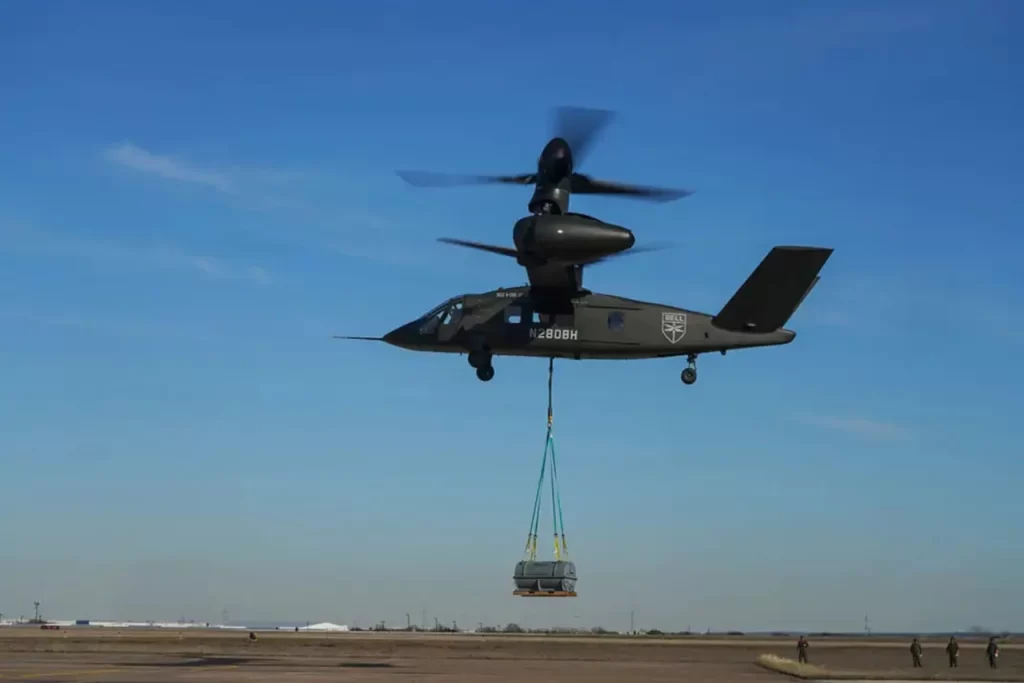Bell (a subsidiary of Textron) won the Future Long-Range Assault Aircraft (FLRAA) competition with the V-280 Valor Tiltrotor. Beginning in 2030, the U.S. Army will gradually replace 2100 Black Hawk helicopters and 1200 Apache assault helicopters with the Valor. The value of the entire FLRAA initiative, including future exports of Valors, might approach $70 billion.
In the first phase, Bell will receive $232 million to construct a “virtual prototype” of the Valor. This digital duplicate of the actual machine will be tested and modified in a virtual environment. Simulators with portable cockpits (perhaps utilising virtual reality glasses) will be used to develop the concepts, tactics, and means of deployment for the Valor conversion planes. The findings will be included in the machine’s final design.
Follow-up contracts for the building of airworthy V-280 Valor prototypes will not be signed until a later date. The first flight of the Valor prototype, a real prototype of the mass-produced machine, will occur in 2025. The development and engineering phase of EMD (Engineering & Manufacturing Development), which involves the manufacturing of physical prototypes, and the initial small-scale production of LRIP (Low Rate Initial Production), raised a total of $7 billion.
In a battle, the Valor overcame the Sikorsky SB-1 Defiant chopper. However, Valor’s victory was not explained. However, one reason is known. The Pentagon uses military contracts to maintain competition in the U.S. military business. Thus, a single company cannot gain a monopoly on producing a particular weapon system or providing a particular capability or technology.
The U.S. Army will likely promote the development of convertibles (Bell) and helicopters (Sikorsky) by placing orders for helicopters with counter-rotating rotors from Sikorsky.
With its Raider X variant, Sikorsky is expected to win the FARA (Future Attack Reconnaissance Aircraft) reconnaissance-combat helicopter competition. In terms of top speed, it exceeds the competing Bell 360 Invictus. The viability of this notion will be tested the following year when the Raider X and 360 Invictus demonstrators are slated to make their maiden voyages.
In addition, Sikorsky got a $2.3 billion order from the U.S. Army in the summer to produce 120 more UH-60M Black Hawk and HH-60 (evac version) helicopters. There is potential for manufacturing up to 255 additional Black Hawks at the cost of $4.4 billion, with a delivery date of 2027. As part of FMS (Foreign Military Sales), the U.S. Army, other U.S. government agencies, and foreign armies will acquire the new helicopters. The Black Hawk will stay in service with the United States Army for decades.
Technically, the Valor is superior because of its “extreme” speed and fighting radius of 1,290 kilometres. Its top speed is 518 kilometres per hour, and its combat radius is 1,290 kilometres. During tests, the Valor demonstration surpassed 555 kilometres per hour.
The FLRAA was established to meet the extended range and cruising speed requirements. Due to the development of long-range weapons, the U.S. Army plans to deploy “helicopters” from significantly more distant air bases. A fast cruising speed is required to cover a large distance and minimise exposure to air defence (ADF) assets. MANPADS (MAN-Portable Air-Defense Systems) surface-to-air missiles are a dangerous threat. The “MANPAD” operator has less time to react the faster the aircraft travels and the lower the altitude.

All future military helicopters (or VTOL machines) must fly far faster, further, and most importantly, at a considerably lower altitude. Major General Walter Rugen, chief of the FVL (Future Vertical Lift) programme, which comprises FLRAA and FARA, states, “Low altitude and speed important.”
Future helicopters and convertibles, according to Rugen, must operate beyond the range of long-range weaponry. In addition, they carry long-range airborne weapon systems capable of eliminating the opponent beyond the enemy’s air defence range.
To achieve the objective, it is required, among other things, to lower the cognitive load of the pilot; the machine’s control, including very fast flight at very low altitude (copying the terrain), must be as fully automated as feasible. The pilot must focus solely on the conduct of warfare, the operating of armament systems, and the execution of tactics.
So, which capabilities will Valor retain? The United States Army will focus mostly on the Pacific, where Valor must traverse vast distances between islands. However, in Europe, ten Valors can transport 140 soldiers (14 troops in each) from the Polish airport Rzeszów to the Ukrainian city of Kherson within two hours without refuelling. These ten helicopters can make the trip three or four times in 24 hours, which is about 420 to 560 troops.
Importantly, the V-280 can transport goods weighing up to 4,500 kilogrammes, such as the howitzer M777A2, at a speed of 280 kilometres per hour. The V-280 can carry a maximum payload of 5,900 kilogrammes.
Such developments significantly increase the U.S. Army’s capacity to undertake airmobile operations:
During Operation Desert Storm in 1991, three infantry brigades of the 101st Airborne Division were carried by helicopter across a distance of 560 kilometres in 96 hours, constituting the greatest airmobile operation in history. The mission of the brigades was to stop the Iraqi National Guard battalions. Using the Valor conversion aircraft, the same task can be accomplished twice as far in half the time.
From this perspective, the introduction of the V-280 is not merely a replacement for the UH-60 Black Hawk helicopters but the development of entirely new army mobility capabilities.
